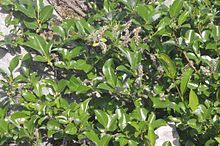You can help expand this article with text translated from the corresponding article in German. (November 2020) Click for important translation instructions.
|
| Salix glabra | |
|---|---|

| |
| Conservation status | |
 Least Concern (IUCN 3.1) | |
| Scientific classification | |
| Kingdom: | Plantae |
| Clade: | Tracheophytes |
| Clade: | Angiosperms |
| Clade: | Eudicots |
| Clade: | Rosids |
| Order: | Malpighiales |
| Family: | Salicaceae |
| Genus: | Salix |
| Species: | S. glabra |
| Binomial name | |
| Salix glabra Scop. | |
Salix glabra, the smooth willow, is a small shrub from the genus of willow (Salix). It is found in the mountainous areas of several European countries.
Description
The smooth willow is a shrub that reaches heights of up to 1.5 meters. All parts of the plant are bare. The bare wood shows short, scattered welts. The bark of the thick branches and twigs is bare and red-brown.
The alternate leaves are arranged in a petiole and a leaf blade. The simple, bald leaf blade is 4 to 6 centimeters long and 1.5 to 2.5 centimeters wide and elliptical or ovate to elongated with a blunt to pointed end, a rounded to wedge-shaped base and a glandular serrate edge. The upper side of the leaf is dark green and very shiny, the underside is whitish and has a thick wax coating. The leaf veins stand out clearly. The stipules are poorly developed.
The smooth willow flowers from May to June just before the leaves shoot. The short inflorescence stem is covered with leaves. The kitten-shaped inflorescences are elliptical with a length of up to 7 centimeters. The bracts of male flowers are monochrome, female flowers are two-colored and bearded at the tip and have a broad nectar gland . Male flowers have two stamens hairy at the base with initially purple-red, later yellow-discolored anthers. The ovary of female flowers is stalked and glabrous. The extended stylus ends in a short and split scar.
The number of chromosomes is 2n = 76 or 114.
Habitat and distribution
The natural distribution area is in Europe in Austria, Southern Germany, eastern Switzerland, Slovenia, Croatia, Bosnia, and in Northern Italy.
The smooth willow grows in the mountains in cool, moist forests on weakly acidic to alkaline, humus to sandy-loamy, nutrient-rich soils in sunny to light-shaded, cool and winter cold locations and is frost hardy . She likes to grow on dolomite . It is a character species of Salicetum glabrae from the association Salicion waldsteininanae. The distribution area is assigned to winter hardiness zone 4 with mean annual minimum temperatures of −34.4 to −28.9 °C (−30 to −20 °F).
Systematics
The first publication of Salix glabra was made in 1772 by Giovanni Antonio Scopoli. The specific epithet glabra comes from Latin and means "smooth" or "bald".
Salix glabra belongs to the Arbuscella section from the subgenus Caprisalix in the genus Salix.
References
- Rivers, M.C. (2017). "Salix glabra". IUCN Red List of Threatened Species. 2017: e.T83826236A86136396. doi:10.2305/IUCN.UK.2017-3.RLTS.T83826236A86136396.en. Retrieved 11 April 2024.
- ^ Andreas Roloff, Andreas Bärtels: Flora der Gehölze. Bestimmung, Eigenschaften und Verwendung. Mit einem Winterschlüssel von Bernd Schulz. 3., korrigierte Auflage. Eugen Ulmer, Stuttgart (Hohenheim) 2008, ISBN 978-3-8001-5614-6, S. 579.
- ^ Jost Fitschen2007en (2007), Gehölzflora (in German) (12., überarbeitete und ergänzte ed.), Wiebelsheim: Quelle & Meyer, p. 762, ISBN 978-3-494-01422-7
{{citation}}: CS1 maint: numeric names: authors list (link) - ^ Erich Oberdorfer: Pflanzensoziologische Exkursionsflora für Deutschland und angrenzende Gebiete. 8. Auflage. Verlag Eugen Ulmer, Stuttgart 2001, ISBN 3-8001-3131-5. Seite 309.
- ^ "Salix glabra". Germplasm Resources Information Network. Agricultural Research Service, United States Department of Agriculture. 32713. Retrieved 2012-08-06.
- Helmut Genaust: Etymologisches Wörterbuch der botanischen Pflanzennamen. 3., vollständig überarbeitete und erweiterte Auflage. Nikol, Hamburg 2005, ISBN 3-937872-16-7, S. 267 (Nachdruck von 1996).